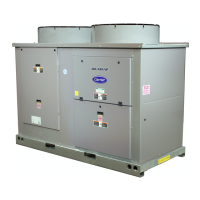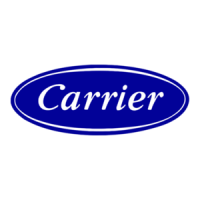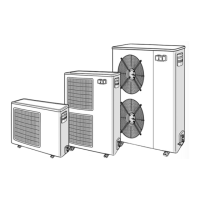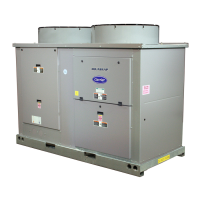92
Contact a Carrier representative to obtain these brushes. Do not
use wire brushes.
Water Leaks — The refrigerant moisture indicator on the
refrigerant motor cooling line (Fig. 2 and 3) indicates whether
there is water leakage during chiller operation. Water leaks
should be repaired immediately.
Water Treatment — Untreated or improperly treated
water may result in corrosion, scaling, erosion, or algae. The
services of a qualified water treatment specialist should be
obtained to develop and monitor a treatment program.
Inspect the VFD
Periodically vacuum or blow off accumulated debris on in-
ternal VFD enclosure components with a high-velocity, low-
pressure blower.
Power connections on newly installed VFDs may relax
and loosen after a month of operation. Turn power off and
re-tighten. Recheck annually thereafter.
Recalibrate Pressure Transducers —
Once a
year, the pressure transducers should be checked against a pres-
sure gage reading. Check all eight transducers: the 2 oil differ-
ential pressure transducers, the condenser pressure transducer,
the cooler pressure transducer, the diffuser pressure transducer
(only for compressors equipped with split ring diffusers), and
the optional waterside pressure transducer pairs (consisting of 4
flow devices: 2 cooler, 2 condenser).
Note the evaporator and condenser pressure readings on the
HEAT_EX screen on the ICVC (EVAPORATOR PRESSURE
and CONDENSER PRESSURE). Attach an accurate set of
refrigeration gages to the cooler and condenser Schrader
fittings. Compare the two readings. If there is a difference in
readings, the transducer can be calibrated as described in the
Troubleshooting Guide section. Oil differential pressure (OIL
PUMP DELTA P on the COMPRESS screen) should be zero
whenever the compressor is off.
Optional Pumpout System Maintenance — For
pumpout unit compressor maintenance details, refer to the
19XR Positive Pressure Storage System Installation, Start-Up,
and Service Instructions.
OPTIONAL PUMPOUT COMPRESSOR OIL
CHARGE — Use oil conforming to Carrier specifications
for reciprocating compressor usage. Oil requirements are as
follows:
ISO Viscosity . . . . . . . . . . . . . . . . . . . . . . . . . . . . . . . . 68 or 220
Carrier Part Number. . . . . . . . . . . . PP23BZ103 or PP23BZ104
The total oil charge is 13 oz. (0.5 L)
Oil should be visible in the pumpout compressor sight glass
both during operation and at shutdown. Always check the oil
level before operating the pumpout compressor. Before adding
changing oil, relieve the refrigerant pressure through the access
valves.
Relieve refrigerant pressure and add oil to the pumpout unit
as follows:
1. Close service valves 2 and 4.
2. Run the pumpout compressor in Automatic mode for one
minute or until the vacuum switch is satisfied and com-
pressor shuts off.
3. Move the pumpout selector switch to OFF. Pumpout
compressor shell should now be under vacuum.
4. Oil can be added to the shell with a hand oil pump
through the access valve in the compressor base.
NOTE: The compressor access valve has a self-sealing fitting
which will require a hose connection with a depressor to open.
OPTIONAL PUMPOUT SAFETY CONTROL SETTINGS
(FIG. 54) — The optional pumpout system high-pressure
switch opens at 185 psig (1276 kPa) and closes at 140 psig
(965 kPa). Check the switch setting by operating the pumpout
compressor and slowly throttling the pumpout condenser
water.
Ordering Replacement Chiller Parts — When or-
dering Carrier specified parts, the following information must
accompany an order:
• chiller model number and serial number
• name, quantity, and part number of the part required
• delivery address and method of shipment.
CAUTION
Hard scale may require chemical treatment for its preven-
tion or removal. Consult a water treatment specialist for
proper treatment.
CAUTION
The chiller must be dehydrated after repair of water leaks.
See Chiller Dehydration section, page 70.
CAUTION
Water must be within design flow limits, clean, and treated
to ensure proper chiller performance and reduce the poten-
tial of tube damage due to corrosion, scaling, erosion, and
algae. Carrier assumes no responsibility for chiller damage
resulting from untreated or improperly treated water.
CAUTION
The motor leads must be disconnected from the VFD
before an insulation test is performed. The voltage
generated from the tester can damage the VFD or drive
components.
WARNING
Before working on any VFD, shut off the chiller, open and
tag all disconnects supplying power to the VFD. After dis-
connecting input power to a VFD and before touching any
internal components, wait five minutes for the DC bus
capacitors to discharge, then check the voltage with a volt-
meter. Failure to observe this precaution could result in
severe bodily injury or death.
WARNING
The disconnect on the VFD front panel does not de-ener-
gizes all internal circuits. Open all internal and remote dis-
connects before servicing the VFD.
WARNING
Never open isolating knife switches while equipment is
operating. Electrical arcing can cause serious injury.
CAUTION
Loose power connections can cause voltage spikes, over-
heating, malfunctioning, or failures.
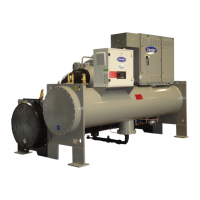
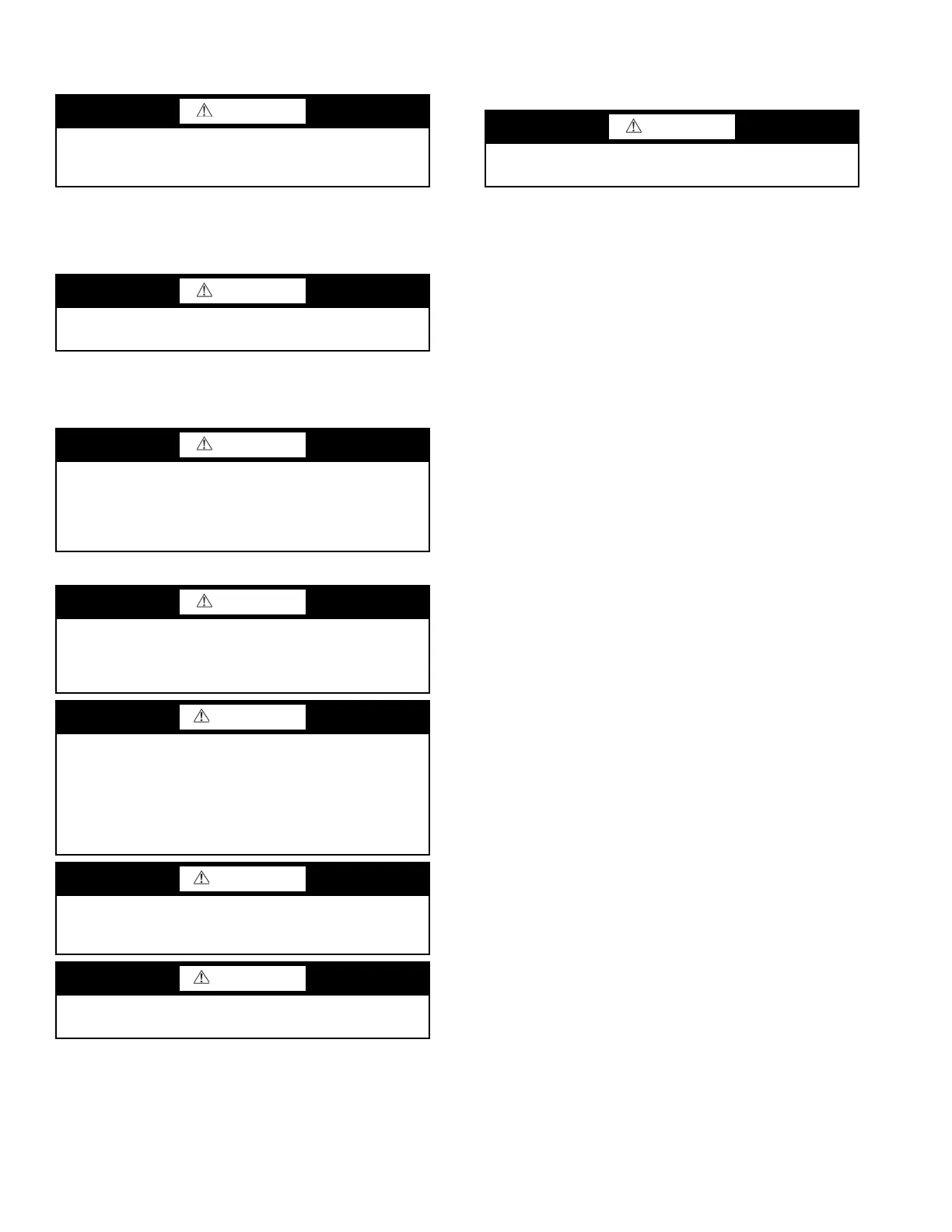